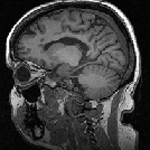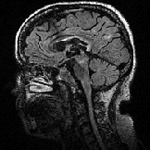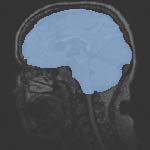Projects:RegistrationLibrary:RegLib C01
From NAMIC Wiki
Revision as of 22:59, 20 November 2009 by Meier (talk | contribs) (Created page with 'Back to ARRA main page <br> Back to Registration main page <br> [[Projects:RegistrationDocumentation:UseCaseInv…')
Home < Projects:RegistrationLibrary:RegLib C01
Back to ARRA main page
Back to Registration main page
Back to Registration Use-case Inventory
Contents
Slicer Registration Use Case Exampe #2: Inter-subject Brain MRI: T1,T2 + MRA, DWI
Objective / Background
This scenario occurs in many forms whenever we wish to align all the series from a single MRI exam/session into a common space. Alignment is necessary because the subject likely has moved in between series.
Keywords
MRI, brain, head, intra-subject, FLAIR, T1, defacing, masking, labelmap, segmentation
Input Data
 reference/fixed : T1 SPGR , 1x1x1 mm voxel size, sagittal, RAS orientation.
reference/fixed : T1 SPGR , 1x1x1 mm voxel size, sagittal, RAS orientation. moving: T2 FLAIR 1.2x1.2x1.2 mm voxel size, sagittal, RAS orientation.
moving: T2 FLAIR 1.2x1.2x1.2 mm voxel size, sagittal, RAS orientation. tag: segmentation labelmap obtained from FLAIR.
tag: segmentation labelmap obtained from FLAIR.- Content preview: Have a quick look before downloading: Does your data look like this? SPGR Lighbox , FLAIR Lighbox
- download dataset to load into slicer (~17 MB zip archive)
Registration Challenges
- the amount of misalignment to be small. Subject did not leave the scanner in between the two acquisitions, but we must expect some head movement.
- we know the underlying structure/anatomy did not change, hence whatever residual misalignment remains is of technical origin.
- we have one or more label-maps attached to the moving image that we also want to align.
- the different series may have different FOV. The additional image data may distract the algorithm and require masking
- the different series may have different resolution / voxel sizes. The SPGR is 1mm isotropic, the FLAIR is 1.2mm isotropic.
- hi-resolution datasets may have defacing applied to one or both sets, and the defacing-masks may not be available
- the different series may have different contrast.
- individual series may contain motion or other artifacts
Key Strategies
- the SPGR is the anatomical reference. It is also higher resolution. Unless there are overriding reasons, always use the highest resolution image as your fixed/reference.
- the defacing of the SPGR image introduces sharp edges that can be detrimental. Best to mask that area. If you have the mask available, use it. But in this case since we already have a skull-stripping mask as part of the labelmap, that is even better. We will load the labelmap and use it as mask in finding the registration
- because the two images are still reasonably similar in contrast, we can choose an intensity ratio as cost function, which is less stable but if successful provides a more precise alignment than mutual information.
Procedures
- download registration parameter presets file (load into slicer and run the registration)
- download/view guided video tutorial
- download power point tutorial
- download step-by step text instructions (text only)
Registration Results
- result transform file (load into slicer and apply to the target volume)
- result screenshots (compare with your results)
- result evaluations (metrics)


